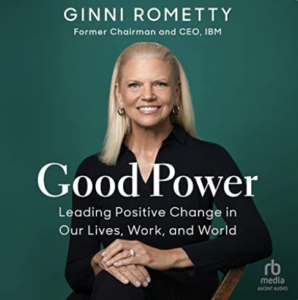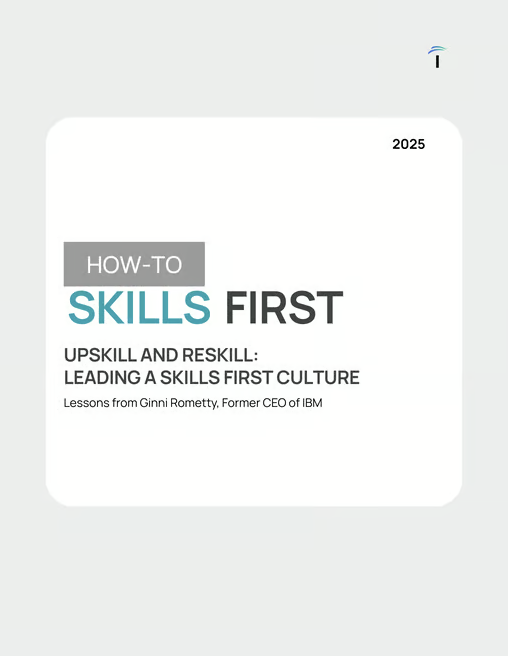
How Ginni Rometty, former IBM CEO, Grew a Global Company with a Skill-Based Approach
We’ve all heard the skills gap problem, but there are indications it’s getting worse. LinkedIn data reveals that by 2030, 70% of the skills used in most jobs will change. The Equal Employment Opportunity Commission’s (EEOC) recent guidance for DEI even aims to focus on using skills to ensure fair and equitable opportunities. With the advancement of AI, and Gen Z projected to make up one-third of the workforce by next year, it’s clear that HR needs a new approach to keep their workforce relevant to the rapid technological and demographic changes.
I came across Ginni Rometty’s book, Good Power: Leading Positive Changes in
Developing people and teams were the secrets to her success—Rometty says it was “a delight to watch others excel.” Developing people became one of her most exciting ventures, and ultimately led to her success in returning IBM—one of the oldest companies in the US, survivor of multiple economic downturns and two wars, who once nearly went bankrupt—into one of the most successful Fortune 500 companies. Rometty’s biggest takeaway? When employees felt invested in, they invested back.
How can we make employees part of the solution? What does it look like to invest in employees rather than see them as a transactional solution or a means to an end? When you think about the employee lifecycle and your company goals for the next 5 years, does it all line up?
Most of us can’t afford to revamp our workforce and hire new talent with in-demand skills like AI—especially when the talent is learning along with us. It’s more efficient to invest in the teams and leaders we have, not continuously hire or find new workers to learn our culture and acquire the knowledge our existing employees have.
SkillFirst Approach
When IBM needed to recruit new talent, Rometty knew that 80% of the workforce, particularly minorities, do not have a college degree. She knew the degree was an obstacle that was preventing them from reaching real talent that could get the job done with the right training.
She says, “My multi-decade journey championing what I later came to call the SkillsFirst hiring and training movement. In a SkillsFirst world, workers no longer see education and training as one-and-done propositions, even for those who graduate college.”
With her SkillsFirst talent strategy, she focused IBM on “building people, not just buying them.” She asked the age-old question, “Are we over-credentialing?” SkillsFirst is a catch-all term that refers to valuing the skills a person has rather than the degrees they have.
Rometty leveraged IBM’s trainers and expert leaders to teach the skills they needed in trade schools. She found that, with the right training and investment, they could tap into a large, new network of talent. After a year of employment, she reports, you couldn’t tell who had a degree and who didn’t. Everyone ended up in the same place.
This is just one of her many success stories with a skills-based approach. The numbers showed that where there were problem-solving skills and a willingness to learn, you can transform and reach a whole new talent pool. But she had to get buy-in from leadership, as it required investment and a top-down approach. Most importantly, they needed to break down the bias that only people with college degrees could do the work.
How to be in Service of, with Skills
She had to activate a skills-based mindset with her leadership team. Behind her SkillsFirst initiative was an attitude of serving their employees and clients. Investing in employees starts with what they value and how they want to grow. No one strives to grow just for the success of the business. They want to be a part of something, and good leaders tap into that drive through learning and development.
In order to grow the business, they had to take their most important asset, their people, which had “mouths and legs”, Rometty said. Individuals with their own set of opinions and ideas, to inspire them to become willing to learn and expand. She found the secret in developing people to be tapping into their belief about themselves and what they could achieve.
During a critical merger between IBM and PwC, she matched her internal consultants to clients that would leverage their skills and allow them the opportunity to be challenged so they would grow. “I wanted people at both companies to feel part of the new reality being created. If others felt that their ideas, individuality, and needs were valued, they’d be more inspired to take part.”
“Everyone had a chance to contribute ideas and see how they fit in, and, I hoped, to feel a sense of belonging.” – Rometty
This is where upskilling with learning and development can take hold. Jay Jones, SHRM’s Talent and Employee Experience expert, says the most important thing is not creating a blanket policy for learning and development that won’t be adopted. Your staff should be at the center of any initiative, merging the growth of the business with the employee’s desire and willingness to learn and grow new skills.
How to Activate a Skills-First Mindset. Belief Matters.
Beyond training for new skills, is motivating people to want to grow. Managers need to tap into articulating the vision for their team and then inspire them to seek new skills to achieve that for the business and themselves.
“Building belief is about moving people to embrace an alternate reality for themselves and others, and then to willingly participate in creating it.” This was imperative as many of Rometty’s initiatives were created for low-income minority groups.
It takes effort and willingness to achieve new skills. “To build belief is a voluntary win, to create enthusiastic buy-in,” she says, “That’s what unleashes discretionary effort. The opposite of building belief is ordering people to do something they don’t buy into and expecting them to perform as if they did.”
You want people to follow you because they choose to. Change constantly fueled by authority or fear is simply not sustainable; it’s also not in service of anyone except those who demand it. Rometty says, “Long-lasting productive shifts in behavior and perspective can’t be dictated.”
Focusing on skills helps our leaders to remember what’s important: developing people and helping them achieve their full potential. Building followership doesn’t just happen through cheering and inspiring speeches. Rometty says, “emotional connection is essential to spark belief, but belief is sealed with information, honesty, and clarity about a situation and the path forward. Facts and feelings. Bridging emotion and execution is the tension of building belief.”
When we make investments in the hires we have, we instill a sense of engagement and inspiring loyalty for the long term. When we are growing the business, we are developing ourselves, and should be focused on the power of “we”. Developing people often sits at the intersection of growing its company and growing its people.
Next Steps to Creating a Skill-based Culture
“Time is the most valuable thing someone can give and you must give them value.” – Rometty
To consider and fulfill someone’s needs to the best of our abilities while in service of our own, this is how we help people realize their potential. This is the soul of learning and development programs. Think about how you service your employees. Sure, you give them a job, but when you are in service to them it’s about so much more than the job. What does their trajectory look like? What do they want to achieve and how can you help them get there to reach satisfaction in their life and for their families?
Balancing the needs of others and our own should be a win/win. When we serve, we step into our employees’ shoes, helping them to reach their potential. This, in turn, serves the business.
“I’ve learned that people will forget what you said, people will forget what you did, but people will never forget how you made them feel.” – Maya Angelou
Rometty understood the concept of stewardship which can help you reimagine how you close the skills gap in your company. When you reconsider that learning and development, is not just a means to an end, but how you impact your employee’s lives, you change the mentality around these training initiatives. You quickly see why a blanket policy doesn’t work and how meaningless incentives, like LinkedIn courses that don’t align with the greater plan, fall short. Seeing the trajectory as someone’s path and chance to develop them into a better version of themselves for their families, will transform your teams and your business.
Don’t focus on learning and development programs as an incentive but as a model and approach to developing and investing in your greatest assets: your people. Adopting a skills-based learning culture will change your business, the way you interact with each other, and you’ll see productivity skyrocket. Aligning your people’s passion, willingness, and drive to learn with the needs of the business is a winning strategy that will work every time.
—
The information contained in this site is provided for informational purposes only, and should not be construed as legal advice on any subject matter.

Advice in Your Inbox
Join our newsletter for free bi-monthly toolkits and downloads on how to hire, support, and retain your best talent.







